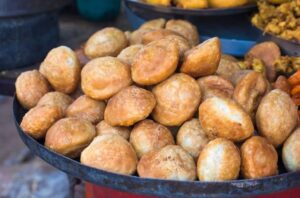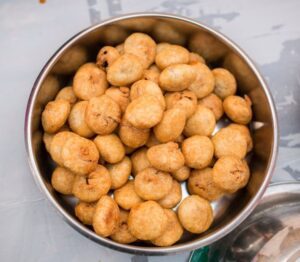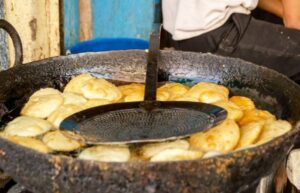Kota Kachori, a beloved street food delicacy hailing from the city of Kota in Rajasthan, India, has captured the hearts and taste buds of food enthusiasts across the nation.
With its origins deeply rooted in Rajasthani cuisine, Kota Kachori is a crispy, deep-fried pastry filled with a delectable spiced mixture. In this article, we will delve into the history and origin of Kota Kachori, explore what sets it apart from other kachoris, unveil the authentic recipe, and provide insights into its caloric content.
Kota Kachori History & Origin:
Kota Kachori, as the name suggests, traces its roots back to the city of Kota in the state of Rajasthan, India. This delectable snack holds a significant place in Rajasthani cuisine and has a fascinating history and origin.
The exact origins of Kota Kachori are not well-documented, but it is believed to have emerged several decades ago. The kachori itself has a long-standing history in the Indian subcontinent, with different variations and regional adaptations across the country.
Kota, a historical city located on the banks of the Chambal River in Rajasthan, has been a prominent center for trade, culture, and gastronomy. The city’s vibrant markets and bustling streets have long been renowned for their delectable street food, with Kota Kachori emerging as one of the iconic snacks.
Kota Kachori gained popularity as a street food delicacy, becoming a favorite among locals and visitors alike. Over time, its fame spread beyond Kota, and it became renowned across Rajasthan and beyond.
The secret to the distinctiveness of Kota Kachori lies in its preparation, with skilled vendors and cooks perfecting the recipe over generations. The larger size, crispy outer crust, and flavorful moong dal filling became defining characteristics that set Kota Kachori apart from other kachoris found in different regions of India.
Today, Kota Kachori has become an integral part of Rajasthani cuisine, celebrated for its unique flavors and textures. It continues to be a beloved street food, with numerous stalls and shops dedicated to serving this delicious snack.
The popularity of Kota Kachori has even transcended regional boundaries, with people from various parts of India and around the world seeking out this culinary delight during their visits to Rajasthan.
What Makes Kota Kachori Unique:
Kota Kachori stands out among its counterparts due to several distinguishing factors that make it a unique and cherished delicacy. Here are the key elements that set Kota Kachori apart from other kachoris:
- Size and Shape: One of the striking features of Kota Kachori is its larger and rounder shape compared to other kachoris found in different regions of India. This substantial size allows for a more generous filling, resulting in a satisfying eating experience.
- Crispy Outer Crust: The outer crust of Kota Kachori is deep-fried to perfection, creating a golden-brown and exceptionally crispy texture. The crust provides a delightful contrast to the soft and flavorful filling, adding a satisfying crunch to each bite.
- Spiced Moong Dal Filling: The filling of Kota Kachori is primarily made from yellow moong dal (split yellow lentils) cooked with a blend of aromatic spices and herbs. The moong dal filling is skillfully seasoned with spices like cumin, ginger, green chili, turmeric, and coriander, resulting in a burst of flavors that tantalize the taste buds.
- Blend of Aromatics: Kota Kachori owes its distinct taste to the expert combination of aromatic spices and herbs used in its preparation. The harmonious blend of cumin, ginger, green chili, turmeric, and coriander creates a flavorful profile that is both spicy and aromatic, enhancing the overall taste experience.
- Heritage and Culinary Tradition: Kota Kachori has a rich heritage and is deeply rooted in the culinary traditions of Rajasthan, particularly in the city of Kota. Passed down through generations, the recipe has been perfected and honed over time, making it an authentic representation of Rajasthani cuisine.
- Street Food Culture: Kota Kachori is a quintessential street food snack that is synonymous with the bustling bazaars and vibrant food stalls of Kota. The experience of enjoying Kota Kachori from a street vendor adds an element of charm and authenticity to its appeal.
- Popular Accompaniments: Kota Kachori is traditionally served with tangy and flavorful chutneys, such as tamarind chutney and mint chutney. These accompaniments complement the robust flavors of the kachori, creating a harmonious balance of tastes.
The unique combination of its size, crispy texture, spiced moong dal filling, aromatic flavors, culinary heritage, and street food culture contribute to the special allure and distinction of Kota Kachori. Indulging in this Rajasthani delight is not only a culinary experience but also an exploration of the vibrant flavors and cultural heritage of the region.
Kota Kachori Recipe:
Now, let’s dive into the authentic recipe for Kota Kachori and recreate this mouthwatering delight in your own kitchen.
Ingredients:
- 2 cups all-purpose flour
- 1/4 cup semolina (optional, for added texture)
- 1/4 cup ghee (clarified butter)
- 1 teaspoon carom seeds (ajwain)
- Salt to taste
- Water (as needed, for kneading the dough)
For the filling:
- 1 cup yellow moong dal (split yellow lentils)
- 2 tablespoons oil (Use healthy Cold Pressed Groundnut Oil)
- 1 teaspoon cumin seeds
- 1/2 teaspoon asafoetida (hing)
- 1 teaspoon ginger paste
- 1 teaspoon green chili paste
- 1/2 teaspoon turmeric powder
- 1 teaspoon red chili powder (Use Mathania Chilli Powder)
- 1 teaspoon coriander powder
- 1/2 teaspoon garam masala
- Salt to taste
- Fresh coriander leaves, chopped (for garnish)
Instructions:
- In a mixing bowl, combine the all-purpose flour, semolina (if using), ghee, carom seeds, and salt. Mix well until the mixture resembles breadcrumbs.
- Gradually add water, a little at a time, and knead to form a smooth and firm dough. Cover the dough with a damp cloth and let it rest for 30 minutes.
- Meanwhile, prepare the filling by rinsing the moong dal and soaking it in water for 30 minutes. Drain the water and set the dal aside.
- Heat oil in a pan and add cumin seeds. Once they splutter, add asafoetida, ginger paste, and green chili paste. Sauté for a minute.
- Add the soaked moong dal, turmeric powder, red chili powder, coriander powder, garam masala, and salt. Cook the mixture until the dal is soft and cooked through. Remove from heat and let it cool.
- Preheat oil in a deep frying pan or kadai. It is recommended to use cold pressed Oils for deep frying as these oils are healthy in comparison to regular refined oils.
- Take a small portion of the dough and roll it into a small disc. Place a spoonful of the cooled dal mixture in the center.
- Gather the edges of the disc and seal the filling, ensuring there are no gaps.
- Gently flatten the filled dough ball with your hands to form a round kachori.
- Carefully slide the kachori into the hot oil and fry on medium heat until it turns golden brown and crisp on both sides.
- Remove the kachori from the oil and drain excess oil on a paper towel.
- Garnish with fresh coriander leaves and serve hot with tamarind chutney or mint chutney.
Kota Kachori Calories:
It’s important to note that the calorie content of Kota Kachori can vary depending on the specific ingredients used and the size of the kachori. The following breakdown provides a general estimate of the calorie content per serving:
- Outer Crust: The outer crust of Kota Kachori is made from all-purpose flour, semolina (optional), and ghee (clarified butter). The calorie content of the crust is approximately 150-180 calories.
- Filling: The filling of Kota Kachori typically consists of yellow moong dal (split yellow lentils) cooked with various spices and herbs. The calorie content of the filling is around 80-120 calories.
- Oil for frying: Deep-frying the kachoris requires oil. The calorie content from frying can vary depending on the amount of oil absorbed by the kachoris. On average, the oil used for frying adds around 40-60 calories per serving.
Considering these estimates, a single serving of Kota Kachori can range from approximately 270 to 360 calories. However, it’s important to remember that these values are approximate and can vary based on the specific recipe and portion size.
If you are concerned about the calorie content, you can modify the recipe by using healthier cooking methods, such as baking or air frying the kachoris instead of deep frying. Additionally, portion control and balancing the kachori with a nutritious and well-rounded meal can help in managing calorie intake.
Remember to enjoy Kota Kachori in moderation as an occasional treat, savoring its unique flavors while also being mindful of your overall dietary goals.
Kota Kachori Tips & Tricks:
Here are some important tips & tricks to make Perfect Kota Kachori at home.
- Rest the dough: After kneading the dough, it’s crucial to let it rest for at least 30 minutes. This resting period allows the gluten to relax and the dough to become more pliable, resulting in a softer and flakier outer crust.
- Keep the oil temperature in check: Maintaining the right temperature of the oil is essential for achieving crispy kachoris. If the oil is too hot, the kachoris will quickly brown on the outside while remaining undercooked on the inside. On the other hand, if the oil is not hot enough, the kachoris will absorb excess oil and become greasy. Maintain a medium heat throughout the frying process to ensure even cooking and a golden-brown crust.
- Don’t overfill the kachoris: While it’s tempting to stuff the kachoris generously, avoid overfilling them as it can lead to difficulties in sealing the dough. Excess filling can also cause the kachoris to burst while frying. Use a moderate amount of filling to strike the right balance between flavors and ease of sealing.
- Seal the edges properly: To prevent the filling from spilling out during frying, it’s important to seal the edges of the kachoris tightly. Pinch the edges together and give them a gentle twist to ensure a secure closure. This will help the kachoris maintain their shape and retain the flavors within.
- Fry in small batches: Avoid overcrowding the frying pan or kadai, as it can lower the oil temperature and result in uneven cooking. Fry the kachoris in small batches, allowing them ample space to float and fry evenly. This will ensure that each kachori attains a consistent texture and color.
- Drain excess oil: Once the kachoris are fried to perfection, transfer them to a paper towel-lined plate or a wire rack to drain off any excess oil. This step helps in reducing the greasiness and retaining the crispy texture.
- Serve with tangy chutneys: Kota Kachori tastes best when paired with tangy and flavorful chutneys. Traditional accompaniments include tamarind chutney, mint chutney, and spicy green chilies. The contrasting flavors of the chutneys enhance the overall taste experience of the kachoris.
- Enjoy them fresh: Kota Kachoris are at their prime when served fresh and hot. The crispy exterior and the piping hot filling combine to create a delightful sensory experience. Serve them immediately after frying to fully savor their flavors and textures.
With these tips and tricks, you’re now equipped to prepare authentic Kota Kachoris that will impress your friends and family. So, roll up your sleeves, follow the recipe, and embark on a culinary adventure filled with the irresistible flavors of Kota Kachori!
Conclusion:
Kota Kachori, with its intriguing history, distinctive flavors, and delightful textures, is a culinary masterpiece that is sure to leave you craving for more. Whether enjoyed as a breakfast item or an evening snack, this delectable treat embodies the essence of Rajasthani cuisine.
So, roll up your sleeves, embark on a gastronomic adventure, and savor the irresistible delight of Kota Kachori – a true triumph of flavors!




